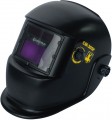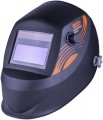Turn-on time
The turn-on time of the filter in the chameleon mask (see "Type"), in other words, the time between striking the arc and darkening the filter to the operating level.
From a safety point of view, the turn-on time should be as short as possible: the faster the "chameleon" works, the less bright light from the arc enters the welder's eyes. On the other hand, reducing the reaction time affects the cost of the product. So for relatively small volumes of work, it is quite acceptable to use relatively “slow” masks — for
100 μs or more(especially since even in the simplest models, the reaction time does not exceed 1200 μs, while theoretically the maximum allowable value is 2000 μs). But for more serious use, you should pay attention to more "fast" options; nowadays, you can find masks with response times
from 75 to 100 µs,
from 50 to 75 µs, and even
less than 50 µs.
Filter class
Class is a complex indicator that determines the overall quality of the light filter in a chameleon mask (see "Type"). The class is indicated by 4 numbers, each of which describes a specific optical parameter. So, the first number indicates the overall clarity and lack of distortion; the second is the degree of light scattering; third — uniformity of blackout (presence/absence of visible blackout spots); the fourth is the angular dependence (how much the filter brightens when the angle of view deviates from the perpendicular). In each case, the larger the number, the worse this parameter is. The perfect indicator is considered to be 1/1/1/1, but in fact it is very difficult to achieve an perfect angular dependence, and there is no need to. Therefore, an indicator of 1/1/1/2 is considered quite sufficient even for a high-end professional filter.
Operating temperature
The range of ambient air temperatures at which the mask is guaranteed to be able to function normally. This parameter is especially important for "chameleons" (see "Functions"), because. the performance of the automatic filter directly depends on external conditions (in particular, at low temperatures, the response time may increase).
Grinding mode
A special mode of operation of the chameleon mask, in which the light filter sensors are completely turned off — thus, it constantly remains transparent and does not respond to any flashes. This mode is useful for jobs that can produce fairly bright flashes of light, but do not require dimming. A classic example of such work is grinding with a “grinder” or a machine tool, when sparks can fly from the workpiece; hence the name of this function —
"grinding" mode.

